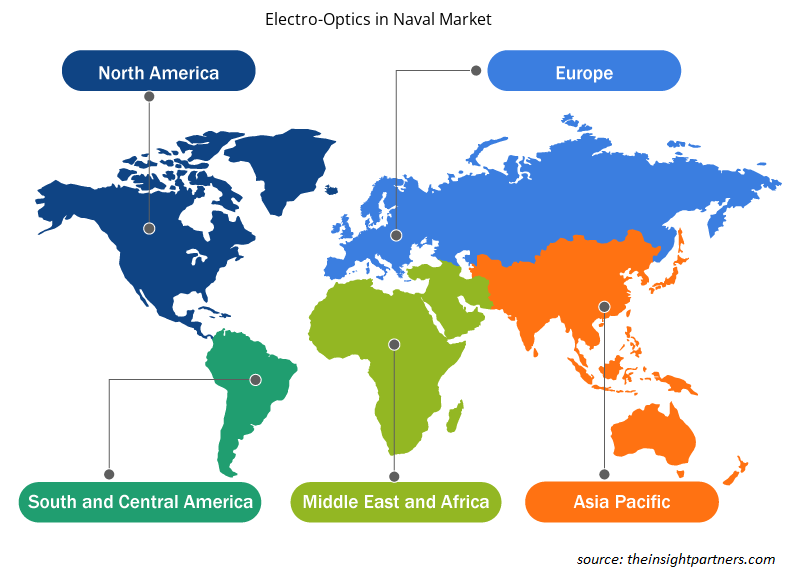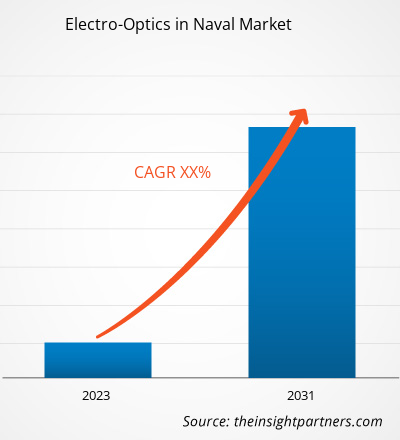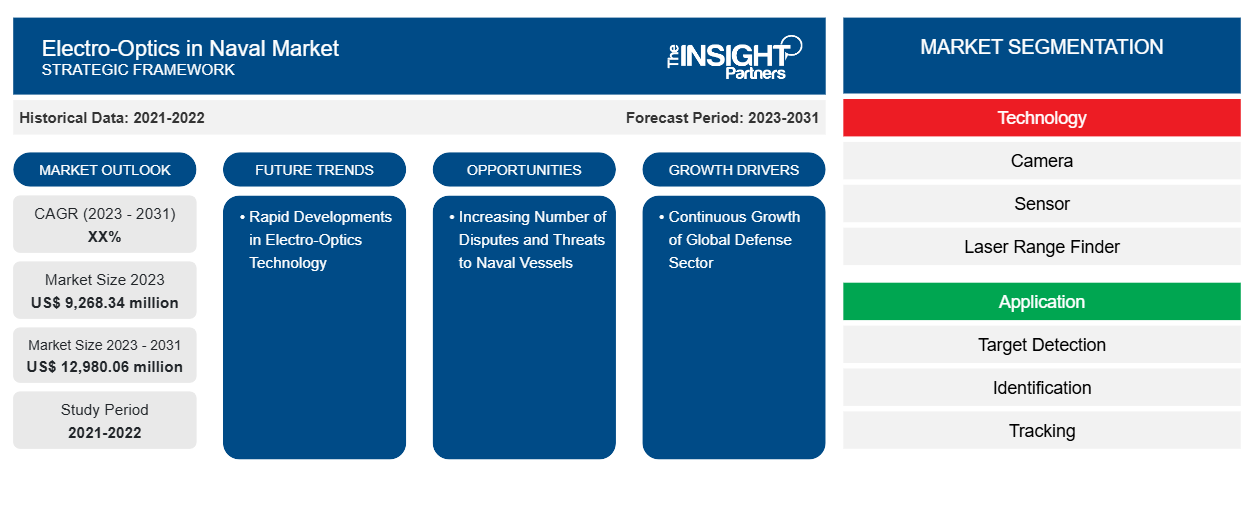Si prevede che le dimensioni del mercato elettro-ottico navale raggiungeranno i 12.980,06 milioni di dollari entro il 2031, rispetto ai 9.268,34 milioni di dollari del 2023. L'elettro-ottica ha consentito l'esecuzione di missioni di successo, possedendo caratteristiche e capacità uniche, più adatte per il targeting navale, la sorveglianza e la consapevolezza della situazione. Le aziende sul mercato stanno progettando una soluzione elettro-ottica per fornire un funzionamento e una sorveglianza superiori in un pacchetto leggero e a basso costo che supporta efficacemente più requisiti di missione per il rilevamento di superficie a spettro completo, l'identificazione, la sorveglianza e la valutazione del bersaglio.
Analisi del mercato elettro-ottica navale
Con l'espansione navale, si registra un aumento e le preoccupazioni per la sicurezza nazionale continuano a crescere nell'attività marittima commerciale per quanto riguarda la costruzione navale e gli investimenti nelle infrastrutture portuali. Inoltre, gli ingenti investimenti nella modernizzazione e nell'aggiornamento della tecnologia elettro-ottica, un aumento della necessità di capacità ISR e l'adozione di veicoli di superficie senza pilota (USV) sono tra i principali fattori che alimentano la crescita del mercato elettro-ottico nella marina. Ad esempio, a settembre 2022, L3Harris Technologies Inc ha ricevuto un contratto dalla Marina degli Stati Uniti del valore di 8,9 milioni di dollari per la fornitura di sensori elettro-ottici per applicazioni di controllo del fuoco sui cannoni di coperta delle navi da guerra. Tuttavia, il ciclo di vita stagnante dei sistemi elettro-ottici navali che riduce la domanda di prodotti per installazioni di retrofit è uno dei principali fattori che limitano la crescita del mercato. Al contrario, si prevede che l'aumento della consapevolezza della situazione in mare, un aumento della necessità di sistemi di sensori migliori che siano altamente affidabili e precisi per il pattugliamento marittimo e rapidi sviluppi e investimenti in R&S creeranno opportunità di crescita redditizie per il mercato nei prossimi anni.
Panoramica del mercato elettro-ottica navale
I sistemi elettro-ottici navali sono costituiti da moduli di imaging multi-sensore che soddisfano le esigenze di sorveglianza, monitoraggio, controllo del fuoco e ricerca e tracciamento panoramici. Inoltre, l'elettro-ottico consente il rilevamento di tutte le minacce aeree e di superficie, sia simmetriche che asimmetriche, indipendentemente dall'ora del giorno e dalle condizioni meteorologiche. Inoltre, per le operazioni di sicurezza in alto mare e costiere, i sistemi elettro-ottici forniscono sistemi di sorveglianza, controllo del fuoco e difesa aerea per diverse imbarcazioni di superficie, tra cui portaerei, fregate , corvette, motovedette oceaniche e costiere e imbarcazioni ad alta velocità. Inoltre, i sensori elettro-ottici sono operativi in varie applicazioni aeree, terrestri e navali, fornendo dati di posizione e orientamento richiesti per il funzionamento e l'acquisizione del bersaglio. Inoltre, i sensori forniscono allerta precoce, monitoraggio delle attività anomale, gestione degli incidenti e capacità complete di osservazione e reazione.
Personalizza questo report in base alle tue esigenze
Riceverai la personalizzazione gratuita di qualsiasi report, comprese parti di questo report, o analisi a livello nazionale, pacchetto dati Excel, oltre a usufruire di grandi offerte e sconti per start-up e università
-
Scopri le principali tendenze di mercato in questo rapporto.Questo campione GRATUITO includerà analisi di dati che spaziano dalle tendenze di mercato alle stime e alle previsioni.
Elettro-ottica nel mercato navale: driver e opportunità
Crescita continua del settore della difesa globale
Il cambiamento nel sistema di guerra moderno ha spinto i governi di tutto il mondo a stanziare ingenti fondi per le rispettive forze militari. L'assegnazione del budget militare consente alle forze militari di procurarsi tecnologie e attrezzature avanzate da produttori nazionali o internazionali. Anche le pratiche di modernizzazione dei soldati e dei veicoli militari sono in aumento in numerosi paesi. Per rafforzare le forze militari con tecnologie avanzate, armamenti , artiglierie, aerei da combattimento, navi militari e veicoli blindati, le forze di difesa di tutto il mondo stanno investendo ingenti somme nei prodotti sopra menzionati. La continua richiesta di nuove tecnologie per operazioni di combattimento e non da parte delle forze di difesa sta aumentando la spesa per la difesa in tutto il mondo.
Aumento del numero di controversie e minacce alle navi militari
A causa dell'aumento delle controversie marittime e delle minacce alle forze navali, i paesi stanno investendo in sistemi elettro-ottici avanzati per applicazioni marittime come il rilevamento delle minacce, la sorveglianza e l'identificazione degli obiettivi. Inoltre, il crescente numero di conflitti territoriali e problemi di confine aumenta il rischio per le risorse marittime, portando a una crescente enfasi sulla sorveglianza, il rilevamento delle minacce e l'identificazione degli obiettivi in mare. Inoltre, le forze della marina si stanno concentrando sempre di più sull'incorporazione e l'integrazione di sistemi di sensori sofisticati e avanzati nelle loro navi navali. Inoltre, è diventato importante per le navi della marina ottenere immagini in movimento da sensori elettro-ottici che forniscono occhi giorno-notte e a lungo raggio sul bersaglio. Inoltre, migliora la capacità della nave di identificare gli obiettivi, supporta l'ingaggio delle armi tramite soluzioni di tracciamento automatico e controllo del fuoco tramite linea di vista ed esegue la valutazione delle minacce. Inoltre, le tensioni costanti tra paesi come Cina-India, India-Pakistan, Cina-Taiwan, Russia-Cina, Stati Uniti-Russia; inoltre, i conflitti in corso tra paesi come Russia-Ucraina, India-Cina e Cina-Taiwan sono alcuni dei principali fattori che generano la domanda di sistemi elettro-ottici nelle forze di difesa di questi paesi. Tale tensione tra i paesi ha spinto la richiesta di operazioni navali navali che a sua volta sta guidando la domanda di telecamere elettro-ottiche, sensori e telemetri laser in diverse regioni.
Analisi della segmentazione del rapporto di mercato dell'elettro-ottica navale
I segmenti chiave che hanno contribuito alla derivazione dell'elettro-ottica nell'analisi del mercato navale sono la tecnologia, l'applicazione e l'uso finale.
- In base alla tecnologia, il mercato elettro-ottico globale in ambito navale è segmentato in telecamere, sensori e telemetri laser. Il segmento delle telecamere ha detenuto una quota di mercato maggiore nel 2023.
- In base all'applicazione, il mercato elettro-ottico globale nel settore navale è segmentato in rilevamento, identificazione e tracciamento del bersaglio; sorveglianza; controllo del fuoco; e altri. Inoltre, la crescente inclinazione verso la sorveglianza sta accelerando la crescita del segmento al più alto tasso di CAGR.
- In base all'uso finale, il mercato elettro-ottico globale nel settore navale è segmentato in difesa e commerciale. Il segmento della difesa ha detenuto una quota di mercato maggiore nel 2023.
Analisi della quota di mercato dell'elettro-ottica in ambito navale per area geografica
Il mercato elettro-ottico globale nel settore navale è suddiviso in cinque regioni principali: Nord America, Europa, APAC, Medio Oriente e Africa (MEA) e Sud America (SAM). Nel 2021, il Nord America deteneva la quota maggiore del mercato elettro-ottico globale nel settore navale. Nel corso degli anni, i paesi del Nord America hanno registrato un aumento della spesa militare per migliorare le capacità delle loro truppe di terra, mare e aria, il che sta portando all'adozione di tecnologie avanzate tra le forze militari. Nel febbraio 2022, la Marina degli Stati Uniti ha assegnato un contratto a Teledyne FLIR, una sussidiaria di Teledyne Technologies, per la manutenzione e la fornitura di sistemi di imaging multisensoriale BRITE Star II per il programma H-1 della Marina degli Stati Uniti. Inoltre, c'è una maggiore adozione di tecnologie avanzate di telecamere e sensori nelle navi militari per applicazioni quali rilevamento di bersagli, tracciamento, sorveglianza e controllo del fuoco. Tutti questi fattori stanno collettivamente stimolando la crescita del mercato.
Approfondimenti regionali sull'elettro-ottica nel mercato navale
Le tendenze regionali e i fattori che influenzano l'Electro-Optics in Naval Market durante il periodo di previsione sono stati ampiamente spiegati dagli analisti di Insight Partners. Questa sezione discute anche i segmenti e la geografia dell'Electro-Optics in Naval Market in Nord America, Europa, Asia Pacifico, Medio Oriente e Africa, e Sud e Centro America.

- Ottieni i dati specifici regionali per l'elettro-ottica nel mercato navale
Ambito del rapporto sul mercato elettro-ottica navale
| Attributo del report | Dettagli |
|---|---|
| Dimensioni del mercato nel 2023 | 9.268,34 milioni di dollari USA |
| Dimensioni del mercato entro il 2031 | 12.980,06 milioni di dollari USA |
| CAGR globale (2023-2031) | XX% |
| Dati storici | 2021-2022 |
| Periodo di previsione | 2023-2031 |
| Segmenti coperti |
Per tecnologia
|
| Regioni e Paesi coperti |
America del Nord
|
| Leader di mercato e profili aziendali chiave |
|
Densità degli attori del mercato: comprendere il suo impatto sulle dinamiche aziendali
Il mercato dell'elettroottica nel mercato navale sta crescendo rapidamente, spinto dalla crescente domanda degli utenti finali dovuta a fattori quali l'evoluzione delle preferenze dei consumatori, i progressi tecnologici e una maggiore consapevolezza dei vantaggi del prodotto. Con l'aumento della domanda, le aziende stanno ampliando le loro offerte, innovando per soddisfare le esigenze dei consumatori e capitalizzando sulle tendenze emergenti, il che alimenta ulteriormente la crescita del mercato.
La densità degli operatori di mercato si riferisce alla distribuzione di aziende o società che operano in un particolare mercato o settore. Indica quanti concorrenti (operatori di mercato) sono presenti in un dato spazio di mercato in relazione alle sue dimensioni o al valore di mercato totale.
Le principali aziende che operano nel mercato dell'elettro-ottica navale sono:
- Safran SA
- L3Harris Technologies, Inc.
- Ultramarittimo
- Immagini di Tonbo
- Aselsan AS
- Azienda
Disclaimer : le aziende elencate sopra non sono classificate secondo un ordine particolare.

- Ottieni la panoramica dei principali attori del mercato elettro-ottico navale
Elettro-ottica nel mercato navale: novità e sviluppi recenti
L'elettro-ottica nel mercato navale viene valutata raccogliendo dati qualitativi e quantitativi post-ricerca primaria e secondaria, che includono importanti pubblicazioni aziendali, dati associativi e database. Di seguito è riportato un elenco di sviluppi nel mercato per innovazioni, espansione aziendale e strategie:
- A novembre 2022, il Naval Undersea Warfare Center (NUWC) ha annunciato un contratto da 173,2 milioni di dollari con SAAB per costruire, testare e consegnare droni. Che possono valutare il comportamento e la firma dei sensori del nemico. (Fonte: Naval Undersea Warfare Center, comunicato stampa)
- A giugno 2022, un team guidato da L3Harris Technologies (NYSE:LHX) è stato selezionato per fornire il sistema Shipboard Panoramic Electro-Optic/Infrared (SPEIR) alla US Navy che garantirà una migliore protezione della flotta. Il contratto iniziale da 205 milioni di $ ha un valore potenziale di 593 milioni di $ se tutte le opzioni vengono esercitate entro marzo 2031. (Fonte: L3Harris Technologies, comunicato stampa)
Copertura e risultati del rapporto sul mercato elettro-ottica navale
Il rapporto “Dimensioni e previsioni del mercato dell’elettro-ottica in ambito navale (2021-2031)” fornisce un’analisi dettagliata del mercato che copre le seguenti aree:
- Dimensioni e previsioni del mercato dell'elettroottica in ambito navale a livello globale, regionale e nazionale per tutti i principali segmenti di mercato interessati dall'ambito di applicazione.
- Dinamiche di mercato come fattori trainanti, vincoli e opportunità chiave
- Elettro-ottica nelle tendenze del mercato navale
- Analisi dettagliata delle cinque forze PEST/Porter e SWOT
- Analisi del mercato elettro-ottica navale che copre le principali tendenze del mercato, il quadro globale e regionale, i principali attori, le normative e i recenti sviluppi del mercato
- Analisi del mercato elettro-ottica navale e della concorrenza, che comprende concentrazione del mercato, analisi delle mappe di calore, attori principali e sviluppi recenti.
- Profili aziendali dettagliati
- Analisi storica (2 anni), anno base, previsione (7 anni) con CAGR
- Analisi PEST e SWOT
- Valore/volume delle dimensioni del mercato - Globale, Regionale, Nazionale
- Industria e panorama competitivo
- Set di dati Excel
Report recenti
Rapporti correlati
Testimonianze
Motivo dell'acquisto
- Processo decisionale informato
- Comprensione delle dinamiche di mercato
- Analisi competitiva
- Analisi dei clienti
- Previsioni di mercato
- Mitigazione del rischio
- Pianificazione strategica
- Giustificazione degli investimenti
- Identificazione dei mercati emergenti
- Miglioramento delle strategie di marketing
- Aumento dell'efficienza operativa
- Allineamento alle tendenze normative























 Ottieni un campione gratuito per - Elettro-ottica nel mercato navale
Ottieni un campione gratuito per - Elettro-ottica nel mercato navale